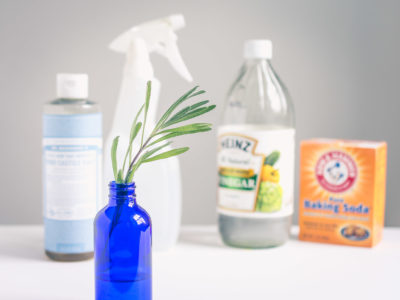It was late at night and I was standing in my kitchen. I had recently finished Marie Kondo-ing my condo and was feeling pleased with my efforts. I assessed every item in my home for a sense of joy, except for the pictures (more than I was willing to do) and one other area…
An unknown impulse compelled me to look under the kitchen sink.
I opened the cabinet and surveyed the familiar scene. Then I saw it—the unopened bottle of dishwasher cleaning agent sitting alone in the darkness, surrounded by a puddle of clear liquid.
Did the sink leak?
I picked up the bottle and felt the slippery liquid on my fingers.
No, the bottle must have exploded in silence.
Its contents smelled faintly metallic and my fingertips started to burn. In the stillness of night, the situation was eerily repulsive. No joy in that bottle.
I threw it out and resolved to clean up my cleaning products.
After doing some research, I decided to go with a combination of white vinegar, baking soda, Dr. Bronner’s liquid soap, and microfiber towels for most regular cleaning. Joy.
That left the issues of laundry detergent, dishwasher detergent, and dish soap, and since making homemade detergents wasn’t (and still isn’t) on my agenda,
I turned to the Environmental Working Group’s (EWG’s) Guide to Healthy Cleaning.
The EWG is a non-profit research, education, and advocacy group dedicated to human and environmental health. In 2012 they created an online health safety database of just over 2,000 cleaning products with letter grades ranging from A to F. The grades indicate the relative toxicity of each product’s individual ingredients combined with the company’s level of ingredient disclosure. (The U.S. does not currently require cleaning product companies to tell us what they put in them.) The EWG ingredient hazard scores are derived from a variety of international toxicity databases.
“A letter grade of “A” indicates very low hazard to health and the environment with robust disclosure of ingredients, while a grade of “F” signifies that the product is highly hazardous or provides little to no ingredient disclosure. A “C” score indicates an average cleaner that poses no overt hazards and provides some disclosure of ingredients. “
~EWG
Since it’s the start of a new year and I’m writing this, I decided to review my choices from a few years ago, and I’m glad I did.
I’ve been buying a Whole Foods brand laundry detergent with an F rating. The bottle looks very similar to the detergent I meant to buy, so maybe I forgot between my house and the store? The Seventh Generation dishwasher detergent I’ve been buying has an A rating, but every now and then I’ve picked up a Trader Joe’s brand when it was more convenient. That detergent gets an F. My Earth & Sun dish soap rates an A, but now I’m wondering if I could just use Dr. Bronner’s soap (A rating) instead. That would certainly make things simpler.
Despite my missteps with the detergents, I find a subtle sense of joy in using cleaning products that are healthier for me and the water systems they ultimately flow into.
I like supporting companies that are committed to serving the Earth and telling me about their ingredients. I trust that by choosing products based on the EWG database, I’m adding to the collective call for transparency and putting positive pressure on companies to continue finding new, non-toxic cleaning solutions. And beyond the database, I love the simplicity of replacing many of my old products with baking soda and vinegar.
If cleaning up your cleaners is on your agenda for 2019, the EWG’s healthy cleaning guide is a great resource. If I were starting again, I’d look up the A’s and compare them to what my grocery store carries.
And maybe download the app, or write a note on your hand, so you don’t forget before you get to the store.

 Gratitude and Oranges
Gratitude and Oranges